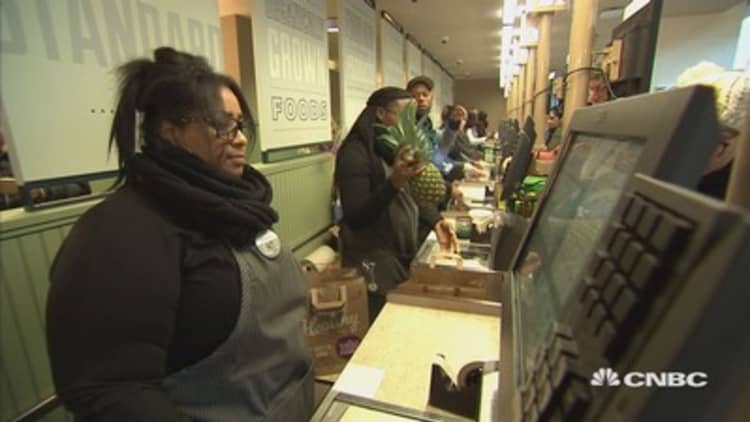
Let's face it. Shoppers have long seen a difference between buying sweaters and shoes on retail websites, and strawberries and chicken.
However, some suspect the return of the milkman might be around the corner.
Online grocery retail is predicted to grow rapidly in the near future. IBIS World quantifies it as an $11 billion industry in just the U.S., and estimates it will grow 9.6 percent annually through the year 2019. (Tweet This)
To get there, a shift will be needed. According to Nielsen, a quarter of global consumers—and only 13 percent of Americans—currently order groceries online. That compares with the 78 percent of the U.S. population ages 15 years and older who bought something online in the first quarter of 2014, according to the latest data from ComScore.
A Nielsen survey suggests consumers are willing to buy more of their groceries online in the future. More than 55 percent told Nielsen they were willing to do so in the future—particularly among millennials.
But "willing to try," and making online grocery ordering and delivery a regular habit, are two different things.
Consumers note several pain points when it comes to an online grocery ordering and delivery process.
Read MoreMissed opportunity? Retail's plus-size problem
Many consumers want to choose their own produce and meat, by touching and seeing it in person. Plus, if the desired product isn't available, many consumers want to make their own choices about substitution.
"You're talking about consumers that like to go into the store for the sensory experience, who want to feel and touch the product, and that's a really strong powerful motivator for consumers specifically within grocery," said James Russo, Nielsen's senior vice president for global consumer insights. "You have to provide a similar experience for consumers within that online environment that allows them to have a high degree of comfort in the quality of that product."
Read MorePain before gain? Coach's earnings 'well worse'
Even if you are ready to outsource those decisions, you have to be home when the food is delivered. Then there's the issue of when the groceries will be delivered, which is often hours after the order is placed. That gap time between ordering and needing to have the groceries on-hand is often a deal breaker for many consumers.
Plus, there's the issue of the cost of product-picking and order delivery. While most consumers do want a more painless grocery shopping process, not many are willing to pay much for the convenience.
Which means grocery retailers with razor-thin profit margins to begin with will need to figure out how to bear the burden of the cost. It's a challenge to make a delivery model financially efficient, particularly in nonurban markets for grocery retailers. Some of the costs include refrigerated trucks and added insurance, delivery drivers, as well as software and technology platform investment.
"The last mile of e-commerce presents sizable logistics and cost concerns that have not yet been solved," Patrick Dodd, president of Nielsen's global retailer vertical, said in the "Future of Grocery" report. "Retailers need to experiment with clear 'delivery' options that circumvent these issues."
'Macro' problem, local solutions
So while companies like Amazon, Whole Foods and Fresh Direct offer some form of online ordering and home delivery, it's yet to be widely adopted by U.S. consumers, particularly those who live outside bigger cities. But the answer might be to partner with start-up on-demand delivery companies.
"While the challenges are very macro, the solutions get very local, quickly and require a collaboration between some very large organizations and some of the smaller flexible, start-up organizations that are playing in this space," said Russo.
Read MoreRetailers with the biggest online businesses
Uber has just started a program in New York City and Chicago called UberEATS, quickly delivering a small sample of ready-to-eat meals. Russo suggested grocery delivery could be a logical next step.
Whole Foods is working with InstaCart to improve its grocery delivery service. Wholesale club Costco also works with InstaCart. The grocery delivery start-up is currently available in 15 major metro areas and charges anywhere from $3.99 to $9.99 for deliveries for non-Express Members. InstaCart Express Members get free delivery on orders $35 or more by joining for $99 a year.
Weighing the possibility of a more competitive grocery-delivery space, InstaCart CEO Apoorva Mehta told CNBC that an Uber entrance into the grocery market wouldn't mean much for InstaCart.
"I think it's a fantastic idea from Uber's perspective, they already deliver passengers, why not deliver packages?" Mehta said.
Amazon is still piloting its Amazon Fresh grocery ordering and delivery service in Los Angeles, Seattle and New York. While delivery on orders more than $35 is free, it costs $299 per year to subscribe to the service.
"Amazon has a fundamental disadvantage in this space, and the reason for that is because we deliver within one hour, two hours, same day from your favorite stores," said Mehta, a former Amazon engineer. "Amazon delivers the next day with their Amazon Fresh program and they deliver it from their warehouses."
Meanwhile, Wal-Mart is piloting online grocery ordering in five cities with curbside pickup or delivery, but it isn't working with a delivery partner.
Peapod said it established not only the first online grocery delivery concept, but also the world's first e-commerce-only company in 1989. It now serves 24 markets in the U.S. but still, the fastest delivery option is next day and the smallest delivery window is a two-hour span.
So while the challenges on both sides of the equation are tangible, so is the financial opportunity, according to Russo.
"When you think about a billion consumers globally are willing to purchase their grocery items online, that's a staggering number, that's an opportunistic number, and one that has not been met just yet," he said.
(CORRECTION: Peapod serves 24 markets. An earlier version of this story misstated the number.)



